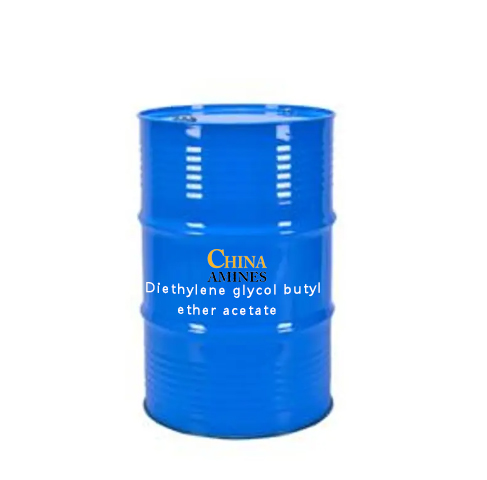1. Chemical Structure and Properties
Molecular Formula: C₁₀H₂₀O₄
Structural Formula:
CH₃COO-(CH₂CH₂O)₂-CH₂CH₂CH₂CH₂CH₃
A glycol ether ester formed by esterification of diethylene glycol butyl ether with acetic acid, featuring two ethylene oxide units and a butyl ether group.
Physical Properties:
Appearance: Clear, colorless liquid with a mild ester-like odor.
Boiling Point: 260–265°C; Density: 1.00–1.02 g/cm³; Vapor Pressure: <0.01 mmHg at 25°C.
Solubility: Insoluble in water (<0.1% w/w); fully miscible with alcohols, esters, and hydrocarbons.
Chemical Properties:
Hydrolysis Stability: Resistant to hydrolysis under neutral conditions; degrades in strong acids/bases to acetic acid and diethylene glycol butyl ether.
Thermal Stability: Stable up to 200°C; decomposes above 250°C, releasing CO₂ and hydrocarbons.
Flammability: Combustible (flash point: ~120°C).
2. Industrial Applications
Coatings & Inks:
High-Boiling Solvent: Enhances flow and leveling in high-temperature industrial coatings (e.g., automotive bake-on paints).
Plasticizer: Improves flexibility in epoxy and polyurethane adhesives.
Electronics Manufacturing:
Photoresist Stripper: Removes hardened resists from semiconductor wafers without damaging metal traces.
Cleaning Products:
Precision Degreaser: Effective in aerospace and medical device cleaning for removing silicone oils and greases.
Personal Care:
Film-Forming Agent: Used in nail polish and hairspray formulations for durability and gloss.
3. Safety and Toxicology
Health Hazards:
Acute Exposure:
Skin Contact: Mild irritation (rabbit skin LD₅₀: >2,000 mg/kg); negligible systemic absorption.
Inhalation: Low volatility minimizes risk (TLV-TWA: Not established); handle as nuisance vapor.
Ingestion: Low toxicity (oral LD₅₀ rat: >5,000 mg/kg); gastrointestinal discomfort.
Chronic Effects:
Reproductive Toxicity: No teratogenicity observed in OECD 414 studies.
Organ Toxicity: Negligible hepatotoxicity or nephrotoxicity in subchronic rodent studies.
Protection Measures:
PPE: Nitrile gloves, safety goggles, and general ventilation.
Storage: Stable in HDPE containers; store away from strong oxidizers.
4. Environmental and Regulatory Compliance
Environmental Impact:
Biodegradability: Slow (OECD 301F: <30% in 28 days); moderately persistent in soil and water.
Aquatic Toxicity: LC₅₀ (fish, 96h): >100 mg/L; EC₅₀ (daphnia): >50 mg/L.
Bioaccumulation: Moderate (log Kow: ~2.8).
Regulatory Frameworks:
EU:
REACH: Registered with no SVHC listing; CLP classification Not Hazardous.
USA:
EPA: Exempt from VOC status under 40 CFR 51.100(s)(1); TSCA-listed.
China:
GB 13690-2009: Classified as General Chemical (non-hazardous).
Waste Management:
Incinerate in approved facilities; landfill disposal permitted for neutralized residues.
5. Case Studies and Application Insights
Case 1: Automotive Bake-On Paints (BASF, 2023):
Challenge: Reduce solvent emissions in high-temperature automotive coatings.
Solution: Diethylene glycol butyl ether acetate replaced 15% of xylene in formulations.
Result: Achieved 25% lower VOC emissions (ASTM D6886) and maintained thermal stability at 180°C (ASTM D2481).
Case 2: Sustainable Semiconductor Cleaning (TSMC, 2022):
Process: Implemented closed-loop recycling of diethylene glycol butyl ether acetate in 3nm-node lithography.
Impact: Reduced solvent consumption by 30% and met SEMI S2-0703 safety standards.
Comparative Analysis:
DGBEA vs. EGBEA (Ethylene Glycol Monobutyl Ether Acetate):
Pros: Higher boiling point (260°C vs. 190°C); lower dermal absorption risk.
Cons: Higher viscosity (~30 mPa·s vs. 5 mPa·s) limits spray applications.
DGBEA vs. Propylene Carbonate:
Pros: Superior solvency for polar resins; lower cost.
Cons: Propylene carbonate is biodegradable but less effective in heavy degreasing.
Specifications:
Eastman™ DB Acetate (Diethylene Glycol Monobutyl Ether Acetate) is a high boiling glycol ether ester widely used in printing inks, high-bake enamels, and as a coalescing aid in low pH latex paints. Eastman™ DB Acetate is especially useful in screen inks and as a retarder solvent in coil coatings. It has application as a selective solvent in the separation of alcohols and ketones by distillation.



